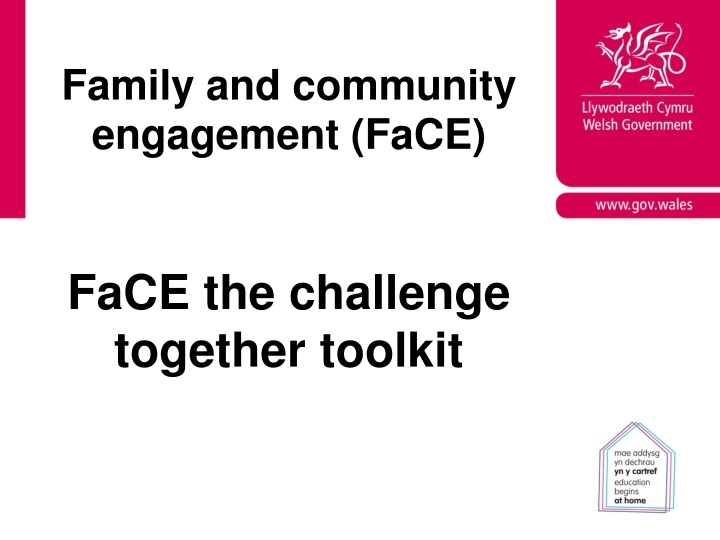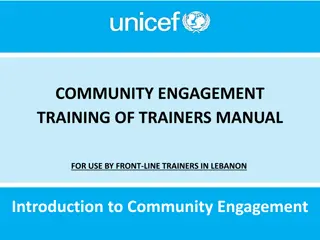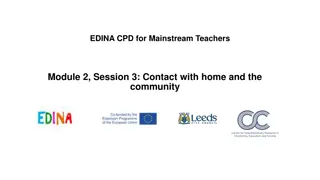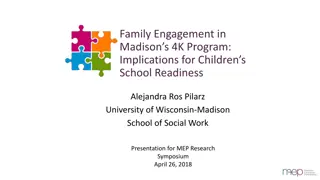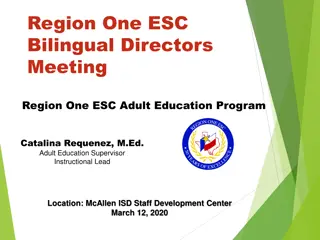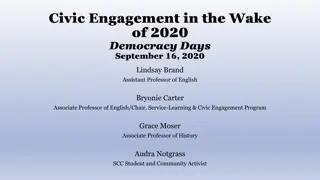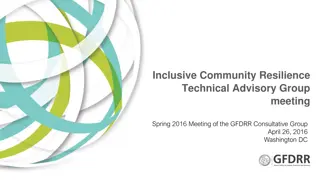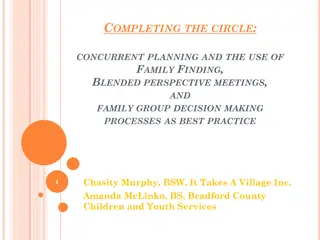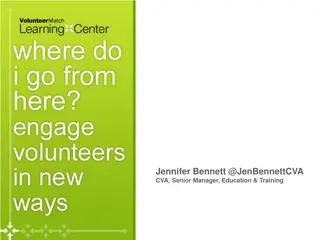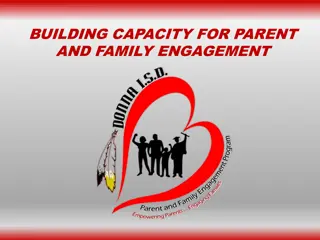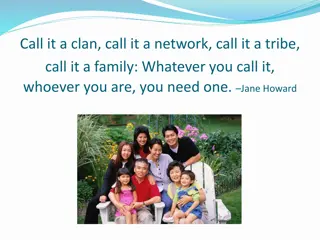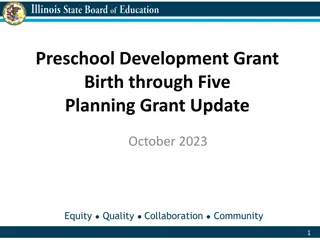Enhancing Family and Community Engagement in Education
Family and community engagement play a crucial role in supporting children's learning and well-being. Working with families can have a positive impact on student achievement and behavior, while community partnerships can help remove barriers to engagement and enhance overall learning outcomes. By fostering strong relationships between schools, families, and community partners, we can create a supportive environment that enables children to thrive academically and emotionally.
Download Presentation

Please find below an Image/Link to download the presentation.
The content on the website is provided AS IS for your information and personal use only. It may not be sold, licensed, or shared on other websites without obtaining consent from the author.If you encounter any issues during the download, it is possible that the publisher has removed the file from their server.
You are allowed to download the files provided on this website for personal or commercial use, subject to the condition that they are used lawfully. All files are the property of their respective owners.
The content on the website is provided AS IS for your information and personal use only. It may not be sold, licensed, or shared on other websites without obtaining consent from the author.
E N D
Presentation Transcript
Family and community engagement (FaCE) FaCE the challenge together toolkit
Why work with families? Parental engagement in children s learning makes a difference it is the most powerful school improvement lever we have. Harris and Goodall (2007) Do Parents Know They Matter? (p.70) Powerful lever for raising attainment. Positive impact on behaviour and well-being. Powerful lever for tackling the impacts of poverty. Build onthe Education begins at home campaign. Family and parent support activities should have the improvement of children s learning as a clear and consistent goal. Goodall and Vorhaus (2011) Review of Best Practice in Parental Engagement Practitioners Summary
Ways that families can support learning Foundation Phase Primary school age 7 11 Secondary school age Conversations. Interest in their school activities. Communicating value of education. Role play. Taking an interest in their studies. Helping them feel they belong in the school. Reading stories. Modelling respectful relationships. Teaching songs. Keeping them focused on learning while also supporting autonomy. Regular bedtime, breakfast and school attendance. Playing with letters and numbers. Regular bedtime, breakfast and school attendance. 10 minutes a day reading. Painting and drawing. Talking about how big/much/many . Communicating aspirations, celebrating achievements. Visiting the library, museums and galleries. Outings to the library, museums and art galleries. Providing a quiet study area. Outdoor trips. Encouraging reading and general discussions. Working with the school to support the child with any particular issues. Supporting social and emotional learning. Outings to cultural venues, extra-curricular activities. Supporting social and emotional learning. Helping their child to be school ready . Working with the school to support the child to work through any particular issues. Supporting course/post-16 selection.
Why work with community partners? Strengthen family engagement, leading to gains in attendance, behaviour and achievement. Learner well-being and standards. Strengthen the school (support, resources, networks). Make a positive contribution to the community. Assessed by Estyn. Extended schools strengthen the ability of families and communities to attend to young people s physical, emotional, cognitive and psychological needs. Coleman (2006) Lessons from Extended Schools It takes a whole village to raise a child. African proverb
Ways that community partners can support learning Remove barriers to family engagement Networking links to target groups. Provide support for learners Professional support for learners. Increase community involvement Learners participating in the community. Improve engagement offer. Professional support for families. Extra-curricular activities. Help tackle impacts of poverty. Arms-length agency forming link to school. Improve learner well-being. Enriched curriculum. Improve learner standards. Community consultation (school development plan). Contribute to community cohesion. Contribute to social capital.
What could it do for our school? Literacy Extensive evidence of the positive impact of parental engagement programmes on literacy. Teaching parents/carers to teach their children reading skills can be twice as effective as asking them to listen to their child read. For example: family learning programme (FLP)to develop early reading skills auction of promises where Dads promise time reading to child family reading club.
What could it do for our school? Numeracy There is robust evidence of the positive and lasting impact of family numeracy programmes on children s academic outcomes. For example: parent/carer prompts for home activities learning logs family learning programmes (FLPs) Teach your child to learn workshops.
What could it do for our school? Metacognition/visible learning Involving families in goal setting with their child and teacher will help engage them in their child s learning, which should: help families support learning at home lead to raised attainment.
What could it do for our school? Tackling the impact of poverty The achievement of working class pupils could be significantly enhanced if we systematically apply all that is known about parental involvement. Desforges and Abouchaar (2003) The impact of parental involvement, parental support and family education on pupil achievement and adjustment
What could it do for our school? Prevent dip in attainment at transition Family involvement in learning is a protective factor attainment is more likely to dip if families aren t involved. We can prevent dips by: engagement over transition in how best to support transition/learning in the next phase multi-agency working for early identification of families needing extra support.
What could it do for our school? Well-being Children s concerns can be sorted out more quickly when their families have a positive relationship with school staff. The Team Around the Family (TAF) approach supports learners and families facing multiple problems.
What could it do for our school? Attendance and behaviour Family engagement can have a significant positive impact, through developing a clear mutual understanding of expectations. Mutual respect and trust are key factors. Working as partners to support a child working through particular issues. Strategies for engaging with families of disengaged learners. Ofsted (2008) found that a close partnership with parents/carers was fundamental to re-engaging with disaffected learners in secondary school.
What could it do for our school? Bullying Important role of families in developing a strategy to tackle bullying. Greater ability to resolve issues when families are on board.
What could it do for our school? Additional learning needs Support families to support learners, for example, through: family workshops to develop parent/carer skills, e.g. signing, PECS (Picture Exchange Communication System) family workshops to develop independent living skills informal support for families, e.g. networking at coffee morning.
What could it do for our school? Team Around the Family Support learner and family well-being and help overcome barriers to learning, as well as: improving attendance improving behaviour reducing exclusions reducing the risk of being a NEET (not in education, employment or training).
What could it do for our school? Community cohesion Ensure all our families are welcomed. Community partners help us to celebrate diversity.
What could it do for our school? Community involvement Deliver community involvement priorities. Enrich the curriculum. Develop curriculum-based projects with external partners to help re-engage disengaged learners.
What could it do for our school? Social capital in our community Help adults/parents/carers in our community develop their skills, confidence and networks, for example, through: family learning programmes (FLPs) to develop parents /carers literacy, numeracy and digital skills adult community learning classes on site participation in community events.
What could it do for our school? Staff well-being A whole-school approach to family and community engagement (FaCE) should allow us to: handle conflict and complaints more effectively, and reduce incidents of abusive behaviour towards staff make parents /carer s evenings more rewarding create a greater sense of cohesion and belonging between the school, families and the community improve learners attendance, behaviour and achievement find external professional support to meet the needs of families and learners.
Summary FaCE the challenge together toolkit A framework with five themes. 1. Leadership for a self-improving system. 2. Embedding a whole-school approach to FaCE. 3. Welcoming families to engage with the school. 4. Helping families to actively support their child s learning. 5. Developing community partnerships and multi-agency working. Good engagement strategies: value the contribution that families and community partners can bring involve the whole school start from, and build on, cultural values of families/communities are based on the understanding of barriers stress personal contact, foster communication, mutual respect and trust.
Next steps Senior leadership team (SLT) member. Governor. Work through FaCE toolkit. Priorities school development plan (SDP). Roles/professional development. Use of Pupil Deprivation Grant (PDG). School-to-school working.
